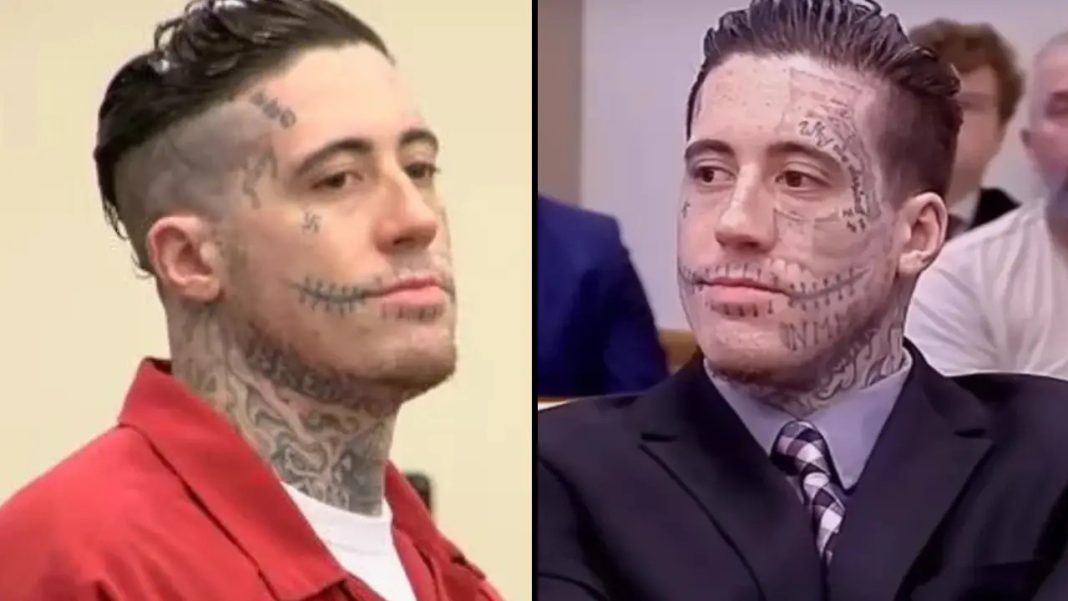Transformation Behind Bars: The Case of Wade Wilson, the ‘Deadpool Killer’
Wade Wilson, infamously known as the ‘Deadpool Killer’, has become a subject of intrigue and horror since he was sentenced to death in 2024 for the murders of Kristine Melton, 35, and Diane Ruiz, 43, in 2019. His story has taken a chilling turn with the release of never-before-seen photographs that depict a drastically altered appearance. Once known for his polished looks during the trial, Wilson now presents a stark contrast, raising questions about the psychological and physical toll of prison life.

The Criminal Charges: A Gruesome Narrative
Wilson faced a litany of charges that not only included two counts of first-degree murder but also grand theft auto, battery, burglary, and petit theft. The prosecution’s case painted a gruesome picture of his crime spree, which allegedly began in October 2019. After a night of drug use and sexual interaction with Melton, Wilson was accused of murdering her in her home. What followed was a chilling sequence of events that would lead him deeper into a cycle of violence.

Following Melton’s murder, Wilson reportedly stole her vehicle and used her phone to reach out to his girlfriend, Melissa Montanez, 41. Their encounter soon turned violent, culminating in Wilson’s flight from the scene in Melton’s car. As he wandered the streets, desperate and unhinged, he encountered Diane Ruiz, who was unsuspectingly approached by Wilson while he was asking for directions. The brutality of her murder, as described by witnesses and investigators, was shocking. It involved strangling Ruiz and then running her over multiple times, allegedly until her body was unrecognizable.

A Shocking Trial and the Public’s Reaction
During the trial, Wilson attempted to mask his numerous facial tattoos, which included deeply controversial symbols that hinted at violent affiliations. The courtroom was a spectacle; many women reportedly became enamored with Wilson, even going so far as to write letters pleading for his release. This shocking reaction sparked outrage from officials, including State Attorney Amira Fox, who referred to Wilson as “the most poor representation of a man there could ever be.” This dichotomy of public fascination versus the heinous nature of his crimes has been a focal point of discussion throughout the case.
The media coverage was relentless, feeding into the morbid curiosity of the public. News outlets frequently reported on the trial proceedings, showcasing not just the evidence against him but also the bizarre cult of personality that began to form around Wilson. This situation raises broader questions about society’s tendency to romanticize criminals, turning them into antiheroes rather than focusing on their victims and the true horrors of their actions. Numerous documentaries and podcasts have delved into his life, analyzing both the psychological profile of a killer and the sensationalism surrounding his case.
Life Behind Bars: The Transformation of Wade Wilson
Recent photographs released under a Freedom of Information request have revealed Wilson’s significant transformation during his time in prison. Once clean-cut and sharply dressed in tailored suits, he now appears unrecognizable, embodying the physical and mental strains of confinement. The images, captured through a monitoring system on a jail-approved tablet, depict a man with cracked and missing teeth, facial weight gain, and a misaligned jaw—signs of a life that has taken a harsh toll.
Currently housed in ‘disciplinary confinement’ at the Union Correctional Institution, Wilson’s behavior behind bars has led to at least ten violations. This status restricts his access to visitors and contributes to a more isolated and austere environment, making it a breeding ground for psychological deterioration. The conditions of his confinement raise questions about the psychological impacts on inmates who are already dealing with the gravity of their crimes and societal rejection.
Public Sentiment and Ongoing Coverage
The case of Wade Wilson has ignited a complex dialogue about criminal justice, mental health, and societal fascination with violence. The stark contrast between the polished persona he presented in court and the current state captured in prison photographs has left many questioning the justice system’s role in managing individuals with severe psychological issues. As more details emerge and public interest continues to wane or wax, Wilson’s case remains a chilling example of the human capacity for both allure and repulsion.
This case has sparked discussions among mental health professionals, legal experts, and the public about how the justice system can better address the needs of mentally ill offenders. Many are calling for reform in how such cases are handled, advocating for increased access to mental health resources and evaluation services to prevent tragedies like Wilson’s from occurring in the first place. On social media, the narrative around Wilson continues to evoke strong feelings, with some advocating for his execution while others argue for rehabilitation. Such polarized views reflect the complexities inherent in discussing crime and punishment in contemporary society.
Conclusion: An Ongoing Story
Wade Wilson’s journey from a seemingly charismatic figure to a man marked by his crimes and the physical consequences of prison life reflects broader themes in society regarding crime, punishment, and the human condition. While he awaits his fate on death row, the evolving narrative surrounding him serves as a reminder of the complexities inherent in criminal justice and the sometimes perplexing reactions of the public to those who commit unspeakable acts.
As this case progresses, it will be crucial to continue examining not only the legal ramifications but also the societal implications of such extreme criminal behavior and the fascination it can provoke. With ongoing coverage, Wade Wilson’s story is far from over, leaving us to ponder the deeper questions it raises about morality, justice, and humanity. Wilson’s case, intertwined with themes of violence, mental illness, and societal response, signifies a continuing saga that challenges our understanding of right and wrong in an increasingly complex world.

















